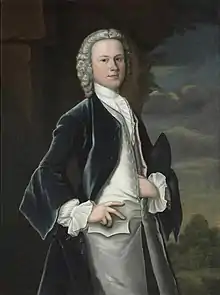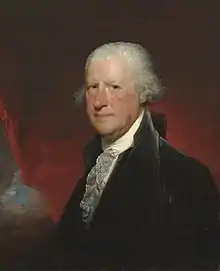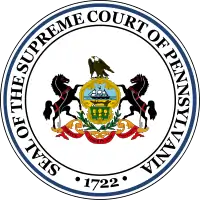Edward Shippen IV
Edward Shippen (February 16, 1729 – April 15, 1806)[1] was an American lawyer, judge, government official, and prominent figure in colonial and post-revolutionary Philadelphia, Pennsylvania.
| Edward Shippen IV | |
|---|---|
 Edward Shippen IV, portrait by Robert Feke | |
| Born | 16 February 1729 |
| Died | 15 April 1806 |
Shippen was born in Philadelphia, the son of merchant Edward Shippen III. He learned law from Tench Francis, Pennsylvania's attorney general. He married his mentor's daughter Margaret Francis in 1753, with whom he had nine children. In 1748 he went to London to complete his law studies at the Middle Temple, and, after returning to Philadelphia, was admitted to the bar. He was appointed judge of the admiralty court in 1755. Three years later he was elected to the city's common council. In 1762 he was appointed prothonotary of the supreme court, a post retained till the Revolution. He became a member of the Pennsylvania Provincial Council in 1770.
Shippen attempted to stay neutral in the American Revolution, hoping that the colonies and the mother country would be reconciled. He did not support the extension of royal authority and was therefore not a Loyalist, but he also opposed the radically democratic Pennsylvania Constitution of 1776, which sought to reduce the hold on government by powerful families like the Shippens.[1]
He received in 1790 an honorary LL.D. degree from the University of Pennsylvania, of which he was a trustee from 1791 until his death. He was also a member of the American Philosophical Society.
In 1791, he was appointed to the Pennsylvania Supreme Court, serving with Jasper Yeates and Edward Burd, both kinsmen and former students. Shippen became chief justice in 1799, but in 1804 was impeached on flimsy, political grounds. The next year the Pennsylvania Senate acquitted him and his associates. Shippen retired to private life and died soon thereafter, on April 15, 1806 in Philadelphia at age 77.
His fourth daughter, Margaret Shippen, was the second wife of Benedict Arnold.
Family

He married Margaret Francis (born August 17, 1735 at Talbot County, Maryland; died May 28, 1794 at Philadelphia), daughter of Tench Francis and Elizabeth Turbutt, on November 29, 1753 at Christ Church, Philadelphia.
Known children of Edward Shippen and Margaret Francis include:
- Elizabeth Shippen was born on September 16, 1754. She married her cousin Col. Edward Burd, son of Col. James Burd and Sarah Shippen, on December 17, 1778. She died on March 26, 1828 at age 73, and was buried at Christ Church, Philadelphia.
- Sarah Shippen was born on February 1, 1756. She married Thomas Lea, son of Thomas Lea and Eleanor, on 21 September 1787. She died in 1831.
- Mary Shippen was born August 15, 1757; she married Dr. William McIlvaine.
- Dr. Edward Shippen was born on December 11, 1758 at Philadelphia. He married Elizabeth Juliana Footman, daughter of Thomas Footman and Eleanor, on November 23, 1785 at Christ Church, Philadelphia. He died on October 22, 1809 at Burlington, New Jersey, at age 50. He was a physician. He and Elizabeth Juliana Footman had 7 children.
- Margaret Shippen (known as "Peggy") was born on July 11, 1760. She married Gen. Benedict Arnold V, son of Benedict Arnold III and Hannah Waterman King, on April 8, 1779 at Philadelphia; she was his second wife. She died on August 24, 1804 at London, England, at age 44.
- John Francis Shippen was born on November 24, 1762. He was buried on January 8, 1763.
- James Shippen was born on October 9, 1766 at Philadelphia. He was buried on November 10, 1769.
Notes
- Randolph Shipley Klein. "Shippen, Edward IV"; American National Biography Online, Feb. 2000.
References
- Genealogy at RootsWeb
- Randolph Shipley Klein, Portrait of an Early American Family: The Shippens of Pennsylvania Across Five Generations. University of Pennsylvania Press, 1975.
External links
| Wikimedia Commons has media related to Edward Shippen, IV. |
- Biographical sketch and portrait at the University of Pennsylvania
- Biography at Virtualology.com (under his great-grandfather, also Edward Shippen)
- Portrait by Robert Feke at the Philadelphia Museum of Art
- Edward Shippen IV at Find a Grave
| Legal offices | ||
|---|---|---|
| Preceded by Thomas McKean |
Chief Justice of the Supreme Court of Pennsylvania 1799–1806 |
Succeeded by William Tilghman |
